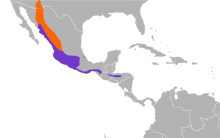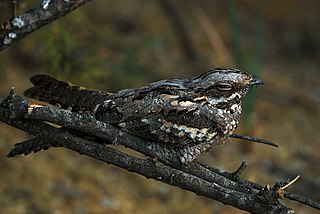
The European nightjar, common goatsucker, Eurasian nightjar or just nightjar, is a crepuscular and nocturnal bird in the nightjar family that breeds across most of Europe and the Palearctic to Mongolia and Northwestern China. The Latin generic name refers to the old myth that the nocturnal nightjar suckled from goats, causing them to cease to give milk. The six subspecies differ clinally, the birds becoming smaller and paler towards the east of the range. All populations are migratory, wintering in sub-Saharan Africa. Their densely patterned grey and brown plumage makes individuals difficult to see in the daytime when they rest on the ground or perch motionless along a branch, although the male shows white patches in the wings and tail as he flies at night.

The cocoa woodcreeper is a species of bird in the subfamily Dendrocolaptinae of the ovenbird family Furnariidae. It is found in Colombia, Costa Rica, Guatemala, Honduras, Nicaragua, Panama, Trinidad and Tobago, and Venezuela.

The unspotted saw-whet owl is a small "typical owl" in subfamily Surniinae. It is found in Costa Rica, El Salvador, Guatemala, Mexico, and Panama.

The ocellated quail is a species of bird in the family Odontophoridae, the New World quail. It is found in El Salvador, Guatemala, Honduras, Mexico, and Nicaragua.

The Yucatan nightjar is a species of nightjar in the family Caprimulgidae. It is found in Belize, Guatemala, Mexico, and Honduras.

The Cuban nightjar, sometimes also Greater Antillean nightjar, is a species of nightjar in the family Caprimulgidae. It is endemic to Cuba.

The Hispaniolan nightjar is a nightjar species endemic to the Caribbean island of Hispaniola, which is shared by the Dominican Republic and Haiti.

The spot-tailed nightjar is a species of nightjar in the family Caprimulgidae. It is found in Honduras, Mexico, Nicaragua, and every mainland South American country except Chile and Uruguay.

The rufous nightjar is a species of nightjar in the family Caprimulgidae. It is found in Argentina, Bolivia, Brazil, Colombia, Costa Rica, Ecuador, Guyana, Panama, Paraguay, Peru, Saint Lucia, Suriname, Trinidad and Tobago, and Venezuela.

The tawny-collared nightjar is a species of nightjar in the family Caprimulgidae. It is endemic to Mexico.

The dusky nightjar or dusky whip-poor-will is a species of nightjar in the family Caprimulgidae. It is found in Costa Rica and Panama.

The silky-tailed nightjar is a species of nightjar birds in the family Caprimulgidae. It is found in Brazil, Argentina, Bolivia, Paraguay, and Peru. Its natural habitat is subtropical or tropical moist lowland forests.
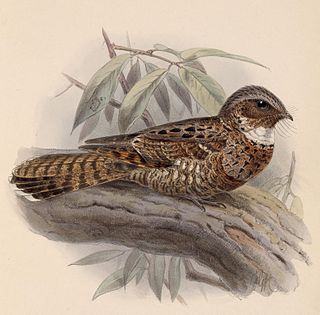
The Yucatan poorwill is a species of nightjar in the family Caprimulgidae. It is found in the Yucatán Peninsula of Belize, Guatemala, and Mexico.

The lyre-tailed nightjar is a species of nightjar in the family Caprimulgidae. It is found in Argentina, Bolivia, Colombia, Ecuador, Peru, and Venezuela.
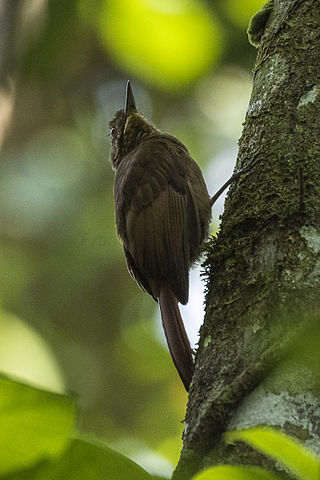
The tawny-winged woodcreeper is a passerine bird in subfamily Dendrocolaptinae of the ovenbird family Furnariidae. It is found in Belize, Costa Rica, Guatemala, Honduras, Mexico, Nicaragua, and Panama.
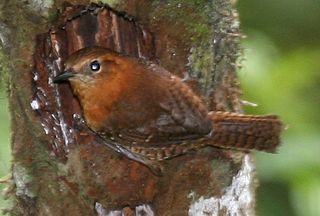
The rufous-browed wren is a species of bird in the family Troglodytidae. It is found in Central America from Mexico south into Nicaragua.

The spotted woodcreeper is a species of bird in the subfamily Dendrocolaptinae of the ovenbird family Furnariidae. It is found in Belize, Colombia, Costa Rica, Ecuador, El Salvador, Guatemala, Honduras, Mexico, Nicaragua, and Panama.

The Mexican whip-poor-will,, is a medium-sized nightjar of the southwestern United States, Mexico, and northern Central America.

Antrostomus is a genus of nightjars formerly included in the genus Caprimulgus. They are medium-sized nocturnal birds with long pointed wings, short legs and short bills.

